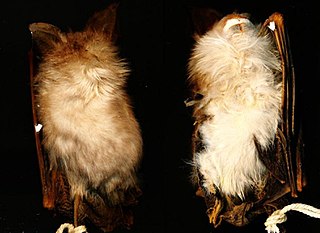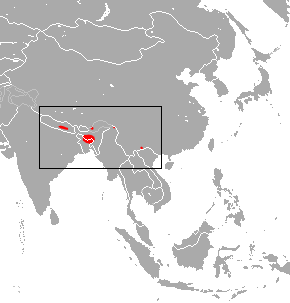
Horseshoe bats are bats in the family Rhinolophidae. In addition to the single living genus, Rhinolophus, which has about 106 species, the extinct genus Palaeonycteris has been recognized. Horseshoe bats are closely related to the Old World leaf-nosed bats, family Hipposideridae, which have sometimes been included in Rhinolophidae. The horseshoe bats are divided into six subgenera and many species groups. The most recent common ancestor of all horseshoe bats lived 34–40 million years ago, though it is unclear where the geographic roots of the family are, and attempts to determine its biogeography have been indecisive. Their taxonomy is complex, as genetic evidence shows the likely existence of many cryptic species, as well as species recognized as distinct that may have little genetic divergence from previously recognized taxa. They are found in the Old World, mostly in tropical or subtropical areas, including Africa, Asia, Europe, and Oceania.
South Sentinel Island is one of the Andaman Islands in the Bay of Bengal. It is 1.6 km (1 mi) long northeast to southwest and up to 1 km wide. At only 1.61 km2, it is much smaller than its counterpart North Sentinel Island and is currently uninhabited. The island belongs to the Port Blair tehsil in the South Andaman administrative district, part of the Indian union territory of Andaman and Nicobar Islands, neighbouring North Sentinel Island.

The greater horseshoe bat is an insectivorous bat of the genus Rhinolophus. Its distribution covers Europe, Northern Africa, Central Asia and Eastern Asia. It is the largest of the horseshoe bats in Europe and is thus easily distinguished from other species. The species is sedentary, typically travelling up to 30 kilometres (19 mi) between the winter and summer roosts, with the longest recorded movement being 180 km (110 mi). The frequencies used by this bat species for echolocation lie between 69–83 kHz, have most energy at 81 kHz and have an average duration of 37.4 ms.

The intermediate horseshoe bat is a bat species of the family Rhinolophidae that is very widespread throughout much of the Indian subcontinent, southern and central China and Southeast Asia. It is listed by IUCN as Least Concern as it is considered common where it occurs, without any known major threats.

The lesser woolly horseshoe bat, also called Beddome's horseshoe bat, is a species of bat in the family Rhinolophidae. It is found in India and Sri Lanka. Its natural habitats are subtropical or tropical moist lowland forests, caves, and urban areas.

The Bokhara horseshoe bat is a species of bat in the family Rhinolophidae. It is found in Afghanistan, Turkmenistan, Uzbekistan, and possibly in Iran and Pakistan.

The Andaman horseshoe bat is a species of bat in the family Rhinolophidae. It is endemic to the Andaman Islands. During the day, it roosts in caves, but may also choose tree hollows.

The convex horseshoe bat is a species of bat in the family Rhinolophidae. It is found in Malaysia and Laos.

Blyth's horseshoe bat is a species of bat in the family Rhinolophidae. It is found across southern Asia from Afghanistan to Vietnam. The species can be identified from its pointed, bifid sella.

The big-eared horseshoe bat is a bat species within the Rhinolophidae native to Asia.

The mitred horseshoe bat is a species of bat in the family Rhinolophidae. It is endemic to India. Little is known about the species, because it is known only from the holotype, the specimen used to describe the species to science. The specimen was collected in Jharkhand in 1844.

The rufous horseshoe bat is a species of bat in the family Rhinolophidae. It is found in China, India, Myanmar, Nepal, Sri Lanka, and Vietnam.

The little Nepalese horseshoe bat is a species of bat in the family Rhinolophidae. It is found in Bangladesh, China, India, Myanmar and Nepal, possibly in Bhutan.

Dobson's horseshoe bat is a species of bat in the family Rhinolophidae. It is found in China, India, Myanmar, and Thailand.
The Poso horseshoe bat or belligerent horseshoe bat is an endangered species of horseshoe bat found only on Sulawesi Island, which is part of Indonesia.
The Sulawesi broad-eared horseshoe bat or Tatar horseshoe bat is a species of horseshoe bat found in Sulawesi, Indonesia.












